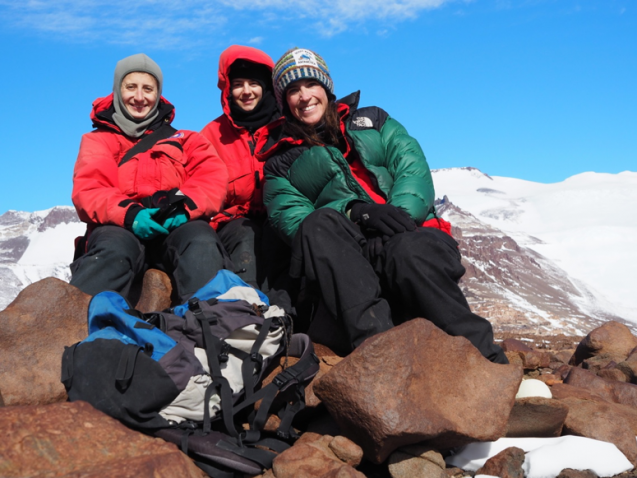Snow Tornadoes, Wind Storms, and More
A team of scientists working in Antarctica faces a host of new challenges.
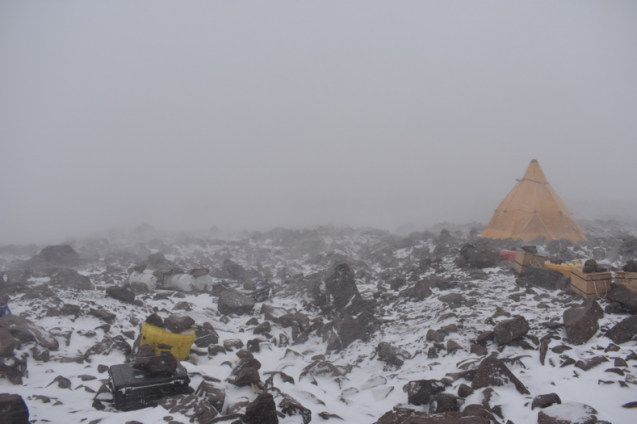
By Jennifer Lamp
This blog post was originally drafted on December 21, but couldn’t be posted until now because the Antarctic fieldwork site lacked an internet connection, plus other challenges. Read the team’s previous blog posts here.
In our previous blog entry, I described the complicated process of attaching sensors to our experimental boulders, in order to monitor their erosion rates and weathering patterns. While the epoxy and cement connecting those acoustic emission (AE) sensors and thermocouples to our boulders cured in the lab tent, our focus shifted to the sampling portion of the project. Unfortunately, Antarctica’s harsh weather decided to make an appearance this week.
Thus far, we’ve experienced mild conditions for Beacon Valley: daily maximum air temperatures have been in low-to-mid 20s (Fahrenheit), with some variable winds and clouds. On Friday (Dec. 14th), the day of our planned trip to the Mullins Glacier headwall to collect samples, we woke up to a concerning amount of fog and snow in Mullins Valley. We wavered about whether to proceed with the trip, but with our instrumentation work paused until the cement set, we ultimately decided to try for it. The helicopter offloaded resupply items at our Beacon Valley camp, then picked us up and dropped us off (hesitantly, I’ll add) a few kilometers away at a meltwater lake near the Mullins Glacier headwall.
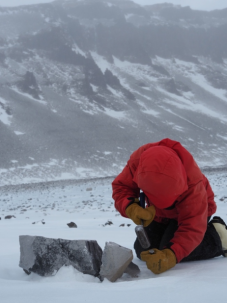
The only exposed ice on Mullins Glacier lies up-valley of this meltwater lake. We planned to hike about one kilometer up the exposed ice to collect rock samples as close to the headwall as possible, then hike back down Mullins Glacier toward our camp in Beacon Valley, collecting more samples along the way. The blowing snow and ice made sampling extremely challenging: our cameras started freezing up, sampling gear was sliding down the glacier, and holding the rock drill (used to separate small samples from large boulders) became difficult. And, we had our first unfortunate encounter with the swirling vortices of snow/ice that we’ve since referred to as “snow tornadoes.” Once Kate and I started having significant trouble keeping warm, we decided to quit sampling and hike directly back to camp. The day wasn’t a complete loss, however; we were still able to collect nine samples, including all of the samples we wanted from the headwall. Among these nine were a few large samples that we will use for both cosmogenic surface exposure dating and mechanical/thermal testing. These were too heavy to carry all the way back to camp, so we placed them a cache near an old helicopter landing site in lower Mullins Valley. [Definition: A helicopter landing site in Mullins and/or Beacon Valley = a small circle with the biggest boulders removed that is just large enough to accommodate helicopter skids, is almost impossible to see from the air, and is the bane of over a decade’s worth of Antarctic helicopter pilots.] I’ll pick these samples up during one of the day trips from McMurdo I have planned later in the season.
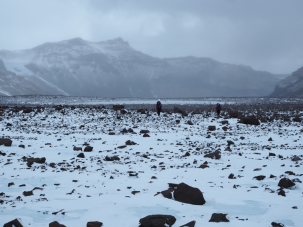
We did additional (and less eventful) sampling in lower Mullins Valley and upper Beacon Valley over the next couple of days. Then, on Monday (Dec. 17th), after determining all of the epoxy and cement had dried, we were ready to move the four boulders out of the lab tent and start recording rock cracking data! Missy had previously cleared off a flat, 2.5-m wide area close to the lab tent, and we carefully carried each boulder to its designated spot, trying not to knock loose the AE sensors or thermocouples in transit.
Each boulder was set out with the same strike/dip it had before being moved from its original location. We connected all of the AE sensors and thermocouples to their associated dataloggers, then tested each sensor to make sure they were reading correctly. We used a heat gun to test the thermocouples and found two that were malfunctioning, an issue easily remedied by attaching new ones (side note: always bring double of what you think you’ll need for an Antarctic field season!).
While testing the AE sensors, the system suddenly began turning itself on and off repeatedly. A quick look at the solar power system showed that the batteries were sufficiently charged, so we were initially stumped. Luckily, a multimeter and a satellite phone call to one of the system engineers the next morning allowed us to locate the problem quickly: a faulty relay or relay driver was constantly disconnecting and reconnecting the AE system from its battery supply. For now, the system is running off of an A/C inverter while we wait for a new relay and driver to be mailed to Christchurch, and make its way onto a flight to McMurdo.
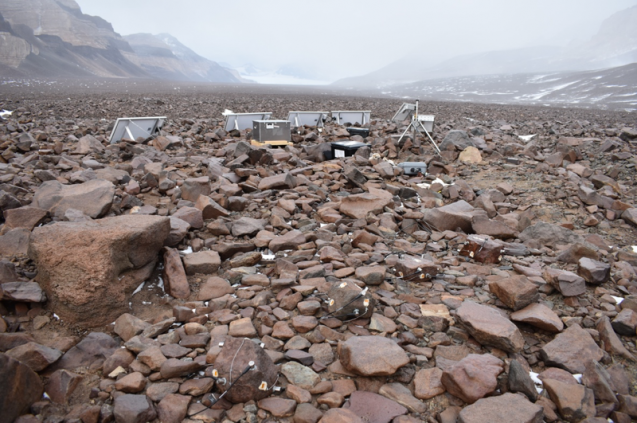
During this time, we also took down the lab tent and set up the fourth solar panel for the AE system in its place, set out the two additional boulders with soil moisture sensors attached, deployed thermistors to monitor near-surface ground temperatures at the site, and did pencil lead breaks on each of the four boulders to make sure AE events could still be recorded after the move. After we finished testing all of the equipment, we rebuilt the desert pavement at the study area, and replaced other large rocks that were removed — we want the site to be as close to its natural state as possible.
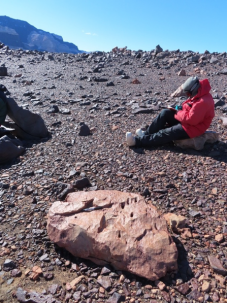
On Dec. 20th, we completed our rock/boulder sampling campaign. We hiked up to lower Mullins Valley to grab samples from an area known as “The Boils” due its hummocky terrain, as well as some extremely old-looking samples from a bench on the eastern side of the valley. It was the nicest weather day we’ve had so far, warm with very little wind and almost cloudless skies (hello sunburn!). We finished the day feeling great about how much we’d been able to accomplish in less than three weeks: all of the rock samples collected, and the instrumentation cheerfully chugging along. It’s a great feeling to know that data is being collected 24/7.
But, as is the norm in Antarctic fieldwork, our happiness was short-lived. Sometime in the early morning hours of Dec. 21st, an intense weather system rolled into the Dry Valleys. The winds quickly increased, with gusts hitting 80 mph by midday (I checked our meteorological station wind data afterward to confirm). The three of us huddled in the endurance tent during the storm, trying to read and listen to music in between regular checks of our tent lines. We used duct tape to reinforce some of the tent pole connections, but as conditions deteriorated, we had to jump up and physically hold the poles in place together during the wind gusts. The tent lines for our Scott tent kept detaching, which meant one or two of us gearing up every 30 mins to head out to fix them. There was so much blowing snow that the next morning I found a 3-inch diameter snowball wedged in the side pocket of my parka — it formed from snow blowing into the side of my coat! I made a “go bag” with essential cold weather gear, communications equipment, and food in case the endurance tent failed and we had to run to the Scott tent, which is rated for higher wind speeds.
Around 8pm the gusts abated, and we were finally able to relax. Amazingly, we didn’t lose any equipment or camp gear. And, excitingly, all the sensors, dataloggers, solar panels, and tripods made it through unscathed! We hope this means the setup is rugged enough to last through the austral winter. The experience was a good reminder of how dangerous complacency can be in Antarctica, and in particular, at isolated field camps with no permanent structures. Kate and I have spent enough time in the McMurdo Dry Valleys to know that the weather can turn quickly, and we were vigilant about stacking boulders on our camp gear, checking tent lines, and stabilizing all of our deployed equipment. At the end of the day however, we were also just plain lucky that the weather didn’t deteriorate further, and that the worst gusts came from the expected direction. Our endurance tent is oblong and oriented with the dominant wind direction; crosswinds of this magnitude would have likely shredded it.
We found out this week that McMurdo will be taking a two-day holiday on Monday/Tuesday of next week (Dec. 24/25). Due to the changed schedule, helicopters will be flying on this coming Sunday (their normal day off). We put in a camp pullout request for Sunday, and decided that the storm was Beacon Valley’s way of supporting our expeditious retreat from the Dry Valleys. Tomorrow (Saturday) will be filled with camp pack-up tasks. Fingers crossed for good flying weather!
